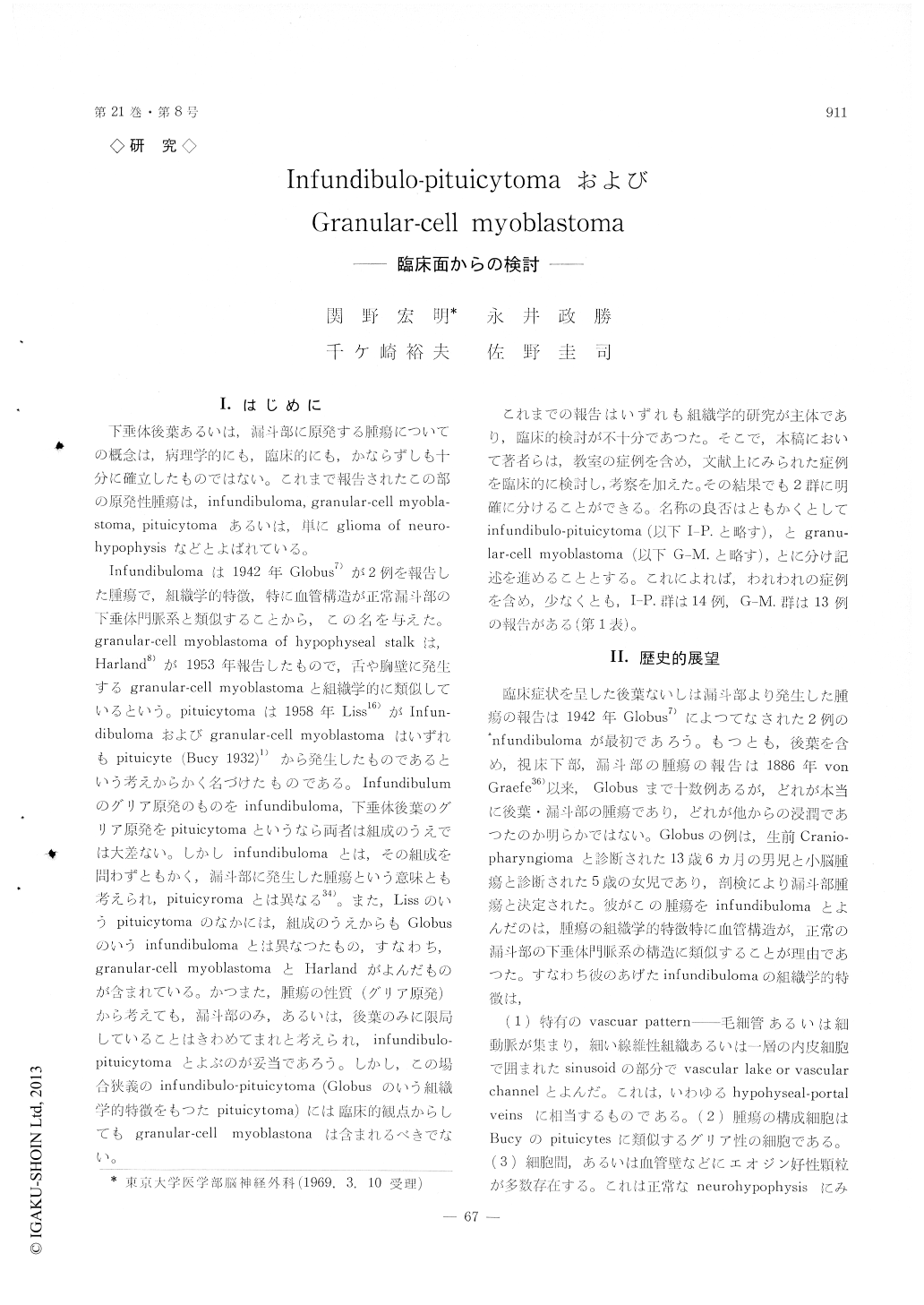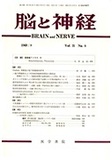Japanese
English
- 有料閲覧
- Abstract 文献概要
- 1ページ目 Look Inside
I.はじめに
下垂体後葉あるいは,漏斗部に原発する腫瘍についての概念は,病理学的にも,臨床的にも,かならずしも十分に確立したものではない。これまで報告されたこの部の原発性腫瘍は,infulldibuloma, granular-cell myobla—stoma, pituicytomaあるいは,単にghoma of neuro—hypophysisなどとよばれている。
Infundibulomaは1942年Gbbus7)が2例を報告した腫瘍で,組織学的特徴,特に血管構造が正常漏斗の下垂体門脈系と類似することから,この名を与えた。granular-cell myoblastoma of hypophyseal stalk は,Harland8)が1953年報告したもので,舌や胸壁に発生するgranular-cell myoblastomaと組織学的に類似しているという。pituicytomaは1958年Liss16)がInfun—dibulomaおよびgranular-cell myoblastomaはいずれもpituicyte (Bucy 1932)1)から発生したものであるという考えからかく名づけたものである。Infundibulumのグリア原発のものをinfundibuloma,下垂体後葉のグリア原発をpituicytomaというなら両者は組成のうえでは大差ない。しかしinfundibulomaとは,その組成を問わずともかく,漏斗部に発生した腫瘍という意味とも考えられ,pituicyromaとは異なる34)。また,Lissのいうpituicytomaのなかには,組成のうえからもGlobusのいうinfundibulomaとは異なつたもの,すなわち,granular-cell myoblastomaとHarlandがよんだものが含まれている。かつまた,腫瘍の性質(グリア原発)から考えても,漏斗部のみ,あるいは,後葉のみに限局していることはきわめてまれと考えられ,infundibulo—pituicytomaとよぶのが妥当であろう。しかし,この場合挟義のinfundibulo-pituicytoma (Globusのいう組織学的特徴をもつたpituicytoma)には臨床的観点からしてもgranular-cell myoblastona は含まれるべきでない。
Three cases of the infundilmlo-pituicytoma and one case of the so-called granular-cell myoblastoma were reported. The clinical data of them were indi-cated in Tab. 2. the histological characteristics of three cases (No. 1-3) were pilocytic astrocytes, vascular channel or lake and eosinophilic colloidal droplets. The histological findings of case 4 was very similar to those of the granular-cell myoblastoma of the neurohypophysis described by Harland in 1953.
In 1942,Globus first reported the neurohypophyseal tumor and gave it the name INFUNDIBULOMA, due to similarity between the neoplastic elements and the normal infundibulum, especially in its vascu-lra pattern ; the hypophyseal portal-veins.Liss and Kahn, in 1958, studied the pituicytes and propounded that INFUNDIBULOMA, described by Globus and GRANULAR-CELL MYOBLASTOMA, described by Harland, should he classified as the same category ; PITUICYTOMA.
In the literature, 14 cases of infundibulo-pitui-cytoma, including our three cases and 13 cases of granular-cell myoblastoma, including one case of ours, have been reported. Age distribution and sex difference of these two groups were illustrated in Fig. 4. It showed that the group of infundibulo-pituicytoma prevailed in males (M : F 10 : 4) and children (average age : 14 years), while the group of granular-cell myoblastoma appeared mainly in females (M : F 3 : 10) and adults (average age : 40 years). In the group of infundibulo-pituicytoma, 12 out of 14 cases steered a fatal course within several years from the onset of the illness. The characta-ristic symptoms and signs of this group were intra-cranial hypertension (11/14), visual disturbances (8/8) and psychic disorders (9/14). Hormonal disturbances were rare. In the group of granular-cell myoblas-toma, visual disturbances were the main symptoms and signs (10/12) and intracranial hypertension ap-peared less frequently than in the group of in-fundibulo-pituicytoma.
On the basis of these clinical findings, we are of the opinion that INFUNDIBULO-PITUICYTOMA and GRANURAL-CELL MYOBLASTOMA should belong to the different clinico-pathological entities.

Copyright © 1969, Igaku-Shoin Ltd. All rights reserved.


